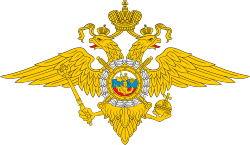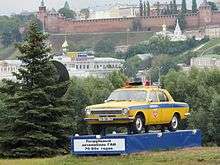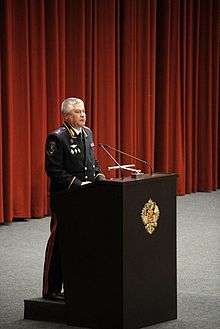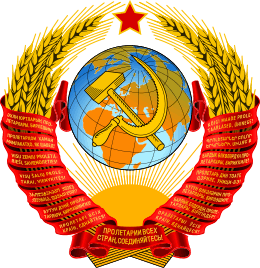Ministry of Internal Affairs (Russia)
The Ministry of Internal Affairs of the Russian Federation (MIA of Russia, Russian: Министерство внутренних дел, МВД, Ministerstvo Vnutrennikh Del, MVD) is the interior ministry of Russia. Emperor Alexander I of Russia founded its predecessor in 1802 in Imperial Russia. The Ministry has its headquarters in Moscow.
| Министерство внутренних дел Российской Федерации Ministerstvo vnutrennih del Rossijskoj federacii | |
 Ministry emblem | |
.svg.png) Flag of the Ministry of the Interior | |
.jpg) Ministry of Internal Affairs (Moscow) | |
| Agency overview | |
|---|---|
| Formed | 8 September 1802 |
| Preceding agency |
|
| Jurisdiction | President of Russia |
| Headquarters | Zhitnaya St. 16, Moscow, Russia 55°43′51″N 37°36′50″E |
| Employees | 907,630 (2012) |
| Annual budget | 1192.2 billion roubles (FY 2011)[1] |
| Minister responsible | |
| Child agencies |
|
| Website | en |
The current Minister of Internal Affairs, General of Police Vladimir Kolokoltsev, assumed office in 2012. He had served as the Moscow Police Commissioner between 2009 and 2012.
History
Russian Empire
Created by Alexander I on 28 March 1802 in the process of government reforms to replace the aging collegia of Peter the Great, the MVD was one of the most powerful governmental bodies of the Empire, responsible for the police forces and Internal Guards and the supervision of gubernial administrations. Its initial responsibilities also included penitentiaries, firefighting, state enterprises, the state postal system, state property, construction, roads, medicine, clergy, natural resources, and nobility; most of them were transferred to other ministries and government bodies by the mid-19th century.
Police
As the central government began to further partition the countryside, the ispravniks were distributed among the sections.[2] Serving under them in their principal localities were commissaries (stanovoi pristav). Ispravniki and pristav alike were armed with broad and obscurely-defined powers, which, combined with the fact that they were for the most part illiterate and wholly ignorant of the law, formed crushing forces of oppression.[3] Towards the end of the reign of Alexander II, the government, in order to preserve order in the country districts, also created a special class of mounted rural policemen (uryadniks, from uriad, order), who, in a time without habeas corpus, were armed with power to arrest all suspects on the spot.[3] These uryadniks rapidly became the terror of the countryside. Finally, in the towns of the rural countryside, every house was provided with a "guard dog" of sorts, in the form of a porter (dvornik), who was charged with the duty of reporting the presence of any suspicious characters or anything of interest to the police.[3]
Secret Police
In addition to the above there was also the secret police, in direct subordination to the ministry of the interior, of which the principal function is the discovery, prevention, and extirpation of political sedition. Its most famous development was the so-called Third Section (of the imperial chancery) instituted by the emperor Nicholas I in 1826. This was entirely independent of the ordinary police, but was associated with the previously existing Special Corps of Gendarmes, whose chief was placed at its head. Its object had originally been to keep the emperor in close touch with all the branches of the administration and to bring to his notice any abuses and irregularities, and for this purpose its chief was in constant personal intercourse with the sovereign.[3]
Following the growth of the revolutionary movement and assassination of Tsar Alexander II, the Department of State Police inherited the secret police functions of the dismissed Third Section and transferred the most capable Gendarmes to the Okhrana. In 1896 the powers of the minister were extended at the expense of those of the under-secretary, who remained only at the head of the corps of gendarmes; but by a law of 24 September 1904 this was again reversed, and the under-secretary was again placed at the head of all the police with the title of under-secretary for the administration of the police.[3]
By World War I, the Department had spawned a counter-intelligence section. After the February Revolution of 1917, the Gendarmes and the Okhrana were disbanded as anti-revolutionary.
Soviet Era

Having won the October Revolution, the Bolsheviks disbanded the tsarist police forces and formed an all-proletarian Workers' and Peasants' Militsiya under the NKVD of the Russian SFSR. After the establishment of the USSR there was no Soviet (federal) NKVD until 1934.
In March 1946, all of the People's Commissariats (NK) were redesignated as Ministries (M). The NKVD was renamed the MVD of the USSR, along with its former subordinate, the NKGB which became the MGB of the USSR. The NKVDs of Union Republics also became Ministries of Internal Affairs subordinate to MVD of the USSR.
Secret police became a part of MVD after Lavrenty Beria merged the MGB into the MVD in March 1953. Within a year Beria's downfall caused the MVD to be split up again; after that, the MVD retained its "internal security" (police) functions, while the new KGB took on "state security" (secret police) functions.
In his efforts to fight bureaucracy and maintain 'Leninist principles', Nikita Khrushchev, as the Premier of the Union, called for the dismissal of the All-Union MVD. The Ministry ceased to exist in January 1960 and its functions were transferred to the respective Republican Ministries. The MVD of the Russian SFSR was renamed the Ministry for Securing the Public Order in 1962.
Leonid Brezhnev again recreated the All-Union Ministry for Securing the Public Order in July 1966 and later assigned Nikolai Shchelokov as Minister; the RSFSR Ministry was disbanded for the second time, the first being at the creation of the NKVD of the Soviet Union. The MVD regained its original title in 1968.
Another role of the reformed MVD was to combat economic crimes, that is, to suppress private business which was largely prohibited by socialist law. This fight was never successful due to the pervasive nature of the black market.
By the mid-1980s, the image of the people's militsiya was largely compromised by the corruption and disorderly behaviour of both enlisted and officer staff (the most shocking case was the robbery and murder of a KGB operative by a group of militsiya officers stationed in the Moscow Metro in 1980). Many high-ranking MVD officers, including the Minister himself, were revealed to be routinely bribed by illegal shadow businesses and criminals.
Russian Federation
The Russian MVD re-formed as the MVD of the Russian SFSR in 1990 following the restoration of the republican Council of Ministers and the Supreme Soviet. It continued in its functions when Russia gained independence from the Soviet Union in 1991. As of 2017 the Ministry controls:
- the Politsiya (formerly Militsiya)
- the General Administration for Traffic Safety
- the Federal Drug Control Service
Since the disbanding of the Tax Police Service in 2003 the MVD also investigates economic crimes.
Two long-time units of the Imperial MVD and NKVD, the Firefighting Service and the Prisons Service, transferred to the Ministry of Emergency Situations in 2001 and to the Ministry of Justice in 2006 respectively. The last reorganization abolished Main Directorates inherited from the NKVD in favour of Departments. In 2012 Vladimir Kolokoltsev became the Minister of Internal Affairs in Russia.
On 5 April 2016 Russian President Vladimir Putin ordered the Internal Troops, OMON (the Special Purpose Mobility Unit), and SOBR (SWAT) forces to form the basis of the new National Guard of Russia, and these moved from MVD control and were reassigned to the Security Council of Russia. In turn and on the same day, the Federal Drug Control Service and the Federal Migration Service merged into the MVD and is now known as the Main Directorate for Drugs Control and the Main Directorate for Migration Affairs, respectively.[4][5][6]
Ministers

| Minister | Start year | End year |
|---|---|---|
| Viktor Yerin | 1992 | 1995 |
| Anatoly Kulikov | 1995 | 1998 |
| Sergei Stepashin | 1998 | 1999 |
| Vladimir Rushailo | 1999 | 2001 |
| Boris Gryzlov | 2001 | 2003 |
| Rashid Nurgaliyev | 2004 | 2012 |
| Vladimir Kolokoltsev | 2012 |
See also
- Awards of the Ministry of Internal Affairs of Russia
- List of Ministers of Interior of Imperial Russia
- Military of Russia
- Militsiya
- Politsiya
- Ministry of Police of Imperial Russia
- Moscow Police
- Saint Petersburg Police
- Sevastopol Police
- Primorsky Krai Police
- Sochi Police
- MVD Ensemble
References
- "Basic parameters of the Russian draft federal budget for 2011"
- From Catherine II's time to that of Alexander II, these chiefs of police were put in power by the ruling nobility. This was changed after the Emancipation reform of 1861.
- Phillips, Walter Alison (1911). . In Chisholm, Hugh (ed.). Encyclopædia Britannica. 23 (11th ed.). Cambridge University Press. p. 876.
- "Putin orders creation of National Guard to fight terrorism, organized crime". rt.com. Retrieved 27 March 2018.
- http://www.interfax.ru/russia/502171
- Galleoti, Mark. "Putin's new National Guard – what does it say when you need your own personal army?". Ukrainian Policy. Retrieved 8 April 2016.
Further reading
- Ronald Hingley, The Russian Secret Police, Muscovite, Imperial Russian and Soviet. Political Security Operations, 1565–1970
- Dominic Lieven (ed.), The Cambridge History of Russia, Volume II: Imperial Russia, 1689–1917, Cambridge University Press (2006), ISBN 978-0-521-81529-1.
External links
| Wikimedia Commons has media related to Ministry of Internal Affairs (Russia). |
- Official website (in English)
- Official website



